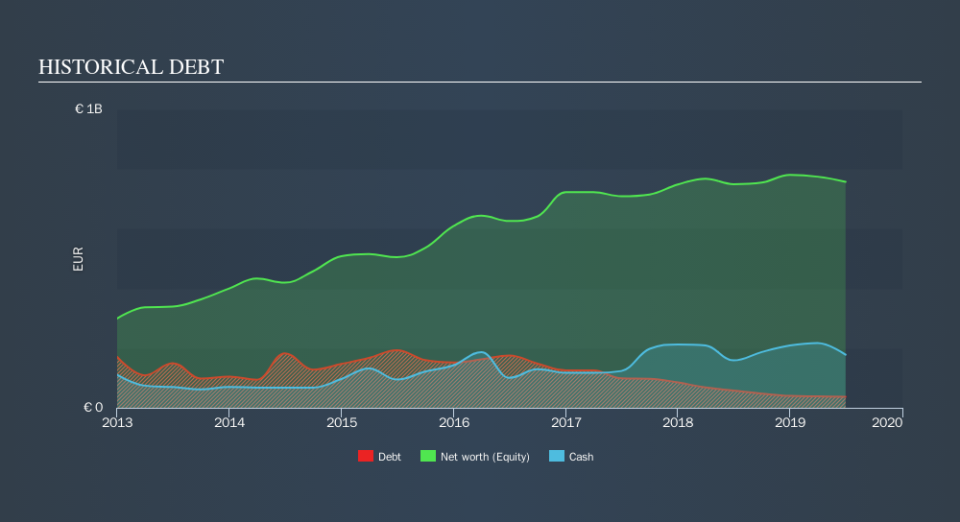Is Salvatore Ferragamo (BIT:SFER) Using Too Much Debt?

David Iben put it well when he said, 'Volatility is not a risk we care about. What we care about is avoiding the permanent loss of capital. So it seems the smart money knows that debt - which is usually involved in bankruptcies - is a very important factor, when you assess how risky a company is. We can see that Salvatore Ferragamo S.p.A. (BIT:SFER) does use debt in its business. But the more important question is: how much risk is that debt creating?
Why Does Debt Bring Risk?
Debt and other liabilities become risky for a business when it cannot easily fulfill those obligations, either with free cash flow or by raising capital at an attractive price. Ultimately, if the company can't fulfill its legal obligations to repay debt, shareholders could walk away with nothing. However, a more common (but still painful) scenario is that it has to raise new equity capital at a low price, thus permanently diluting shareholders. Of course, plenty of companies use debt to fund growth, without any negative consequences. The first step when considering a company's debt levels is to consider its cash and debt together.
View our latest analysis for Salvatore Ferragamo
What Is Salvatore Ferragamo's Debt?
You can click the graphic below for the historical numbers, but it shows that Salvatore Ferragamo had €37.3m of debt in June 2019, down from €57.9m, one year before. But on the other hand it also has €178.2m in cash, leading to a €140.9m net cash position.
How Healthy Is Salvatore Ferragamo's Balance Sheet?
According to the last reported balance sheet, Salvatore Ferragamo had liabilities of €419.6m due within 12 months, and liabilities of €625.9m due beyond 12 months. On the other hand, it had cash of €178.2m and €193.3m worth of receivables due within a year. So its liabilities outweigh the sum of its cash and (near-term) receivables by €673.9m.
Salvatore Ferragamo has a market capitalization of €2.68b, so it could very likely raise cash to ameliorate its balance sheet, if the need arose. However, it is still worthwhile taking a close look at its ability to pay off debt. Despite its noteworthy liabilities, Salvatore Ferragamo boasts net cash, so it's fair to say it does not have a heavy debt load!
But the other side of the story is that Salvatore Ferragamo saw its EBIT decline by 5.1% over the last year. If earnings continue to decline at that rate the company may have increasing difficulty managing its debt load. The balance sheet is clearly the area to focus on when you are analysing debt. But it is future earnings, more than anything, that will determine Salvatore Ferragamo's ability to maintain a healthy balance sheet going forward. So if you're focused on the future you can check out this free report showing analyst profit forecasts.
Finally, while the tax-man may adore accounting profits, lenders only accept cold hard cash. While Salvatore Ferragamo has net cash on its balance sheet, it's still worth taking a look at its ability to convert earnings before interest and tax (EBIT) to free cash flow, to help us understand how quickly it is building (or eroding) that cash balance. During the last three years, Salvatore Ferragamo generated free cash flow amounting to a very robust 86% of its EBIT, more than we'd expect. That puts it in a very strong position to pay down debt.
Summing up
While Salvatore Ferragamo does have more liabilities than liquid assets, it also has net cash of €140.9m. The cherry on top was that in converted 86% of that EBIT to free cash flow, bringing in €162m. So we are not troubled with Salvatore Ferragamo's debt use. Above most other metrics, we think its important to track how fast earnings per share is growing, if at all. If you've also come to that realization, you're in luck, because today you can view this interactive graph of Salvatore Ferragamo's earnings per share history for free.
If you're interested in investing in businesses that can grow profits without the burden of debt, then check out this free list of growing businesses that have net cash on the balance sheet.
We aim to bring you long-term focused research analysis driven by fundamental data. Note that our analysis may not factor in the latest price-sensitive company announcements or qualitative material.
If you spot an error that warrants correction, please contact the editor at editorial-team@simplywallst.com. This article by Simply Wall St is general in nature. It does not constitute a recommendation to buy or sell any stock, and does not take account of your objectives, or your financial situation. Simply Wall St has no position in the stocks mentioned. Thank you for reading.

 Yahoo Finance
Yahoo Finance 
